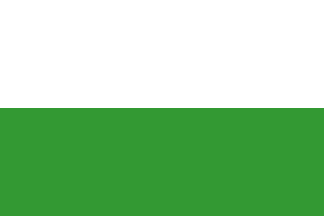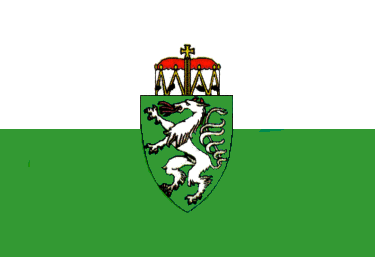 Flagge "Aufnäher Flagge Steiermark
(8,5 x 5,5 cm)" bei fahnenversand.de kaufen.
Flagge "Aufnäher Flagge Steiermark
(8,5 x 5,5 cm)" bei fahnenversand.de kaufen.
 Flagge "Aufnäher Flagge Steiermark
(8,5 x 5,5 cm)" bei fahnenversand.de kaufen.
Flagge "Aufnäher Flagge Steiermark
(8,5 x 5,5 cm)" bei fahnenversand.de kaufen.
 Flagge "Flagge der Steiermark
(150 x 90 cm)" bei fahnenversand.de kaufen.
Flagge "Flagge der Steiermark
(150 x 90 cm)" bei fahnenversand.de kaufen.
 Flagge "Stockflagge Steiermark
(45 x 30 cm)" bei fahnenversand.de kaufen.
Flagge "Stockflagge Steiermark
(45 x 30 cm)" bei fahnenversand.de kaufen.
Last modified: 2025-11-15 by martin karner
Keywords: steiermark | styria | panther | land | landesfarben | state flag | state service flag | crown: ducal hat |
bicolour: white-green |
Links: FOTW homepage |
search |
disclaimer and copyright |
write us |
mirrors

|

|
| image by Rob Raeside |
image by Peter Diem |
adopted 1960 |
See also:
The shade of green used on the Styrian flag is fir-tree green. The
people of Styria are very proud of their well-preserved forests of fir trees.
The crowns on the flags of the Austrian states are all different because the
Länder have
very different historical backgrounds. The Styrian arms are topped by the
(still-existent) ducal hat of Styria.
Peter Diem, 16 August 2002
Arms: Vert, a heraldic panther argent, armed, horned and breathing flames
gules. The shield ensigned of an archducal coronet.
Mike Oettle, 19 August 2002
Concerning the arms of Steiermark/Styria,
I consulted the presently best publication referring to the topic:
Peter Diem (1995), Die Symbole Österreichs [die95].
On p. 340 you'll find the exact wording of the Styrian
Constitution from 1960, paragraph 6:
"(1) Die Farben des Landes sind weiss-grün (The country's colors are white and green).In all the respective laws and descriptions the name of the fictitious animal is always blazoned "Panther". First historical evidence of the panther was revealed on seals of Margrave Otakar III in 1160. Soon the sign became representative for Styria as well as for Kärnten (= Carinthia). For the first time the "Zürcher Wappenrolle" from c. 1340 depicted it in the still valid colors.
(2) Das Wappen des Landes ist in grünem Schild der rotgehörnte und gewaffnete silberne Panther, der aus dem Rachen Flammen hervorstösst. Der Wappenschild trägt den historischen Hut (The country's arms are on a green shield the red-horned and armed silver panther, exhausting flames from his throat. The shield bears the historical hat)."
Dieter Linder, 28 April 1997
The animal on the arms of Styria is a "heraldic panther".
Styria became a duchy in 1180. Because it was a Carantanian
country known as the Carantanian March before, Styria had a black
panther in the arms. Later after the dispute with Carinthia,
Styria changed colours to green and white which are still in use
today. Usually there is also a crown or so-called "ducal
hat" over the arms of Styria.
I'm enclosing text from the book about Slovenian symbols written
by Jozko Savli:
Black Panther – Carantanian coat of arms
Carantania, as all historical royalties and principalities, had its own battle-sign. It can be found already in the middle of the 12th century as a coat of arms or signet of Carantanian countries, Carinthia and its Carantanian March (later Styria).
This sign on the arms is a black panther on a silver shield, which had been attested for the first time on Margrave Otakar III Trangau's shield (the signet is dated 1160). Previously a panther had been situated also on numerous reliefs, which are from Roman and pre-Roman Noricum.
Nevertheless, the symbol of panther is thousands of years old. It can be found on pictures in caverns from Stone Age and later in all early cultures from Asia Minor to Egypt and Greece. In Greek mythology it is together with God Dionysius, later the Roman Bacchus, and with them it was spread over all Mediterranean countries in the ancient period.
In early Christianity the writer Physiologus from Alexandria used the image of a panther in his book about animals, as a symbol for the diffusion of the Gospel, upon the pretext it diffuses a sweet scent (which was a symbol of Gospel) and animals used to follow this scent, which were also caught by him. His only enemy was a dragon (a symbol of evil).
The fact that panther became the symbol and also the coat of arms of Carantania and remained for centuries on the flag of Carantanian Austrian countries calls for another examination of the political history of this country and also its inclusion within the Roman Empire. Till now this history has been interpreted as the German enslavement of Carantanians i.e. Slovene people.
The coat of arms with the panther and its symbolism reveals a completely different period of political happenings in the Middle Ages in this part of Middle Europe. So, Carantania and Slovene people had a historical role, which has not been known up to now.
Uros Zizmund, 1 May 1997







